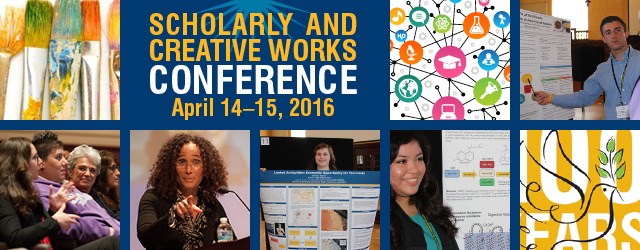
All Conference Presentations, Performances and Exhibits
Staging Collaboration: Classroom Design in Higher Education for Career-readiness
Location
Guzman 111
Start Date
4-15-2016 3:20 PM
End Date
4-15-2016 3:35 PM
Student Type
Graduate
Faculty Mentor(s)
Madalienne F. Peters, Ed.D.
Presentation Format
Oral Presentation
Abstract/Description
The 21st century economy is being driven by innovation; instigating knowledge and adding value through creative problem-solving. Higher education institutions can serve student career-readiness by harnessing innovation skills. The 21st century knowledge worker is part of an overtly-informed, highly collaborative high tech culture. Knowledge workers leverage their ideas with the ideas of others through collaboration with blogs, skype, wikis, and social networks to instigate and produce new knowledge. In the 21st century workplace, face-to-face collaboration of our creative skills and ideas are shared in a social process causal to innovation. The problem is that the the ability and flexibility to align goals and resources with others in real time is often in short supply. Collaborators with diverse skills and perspectives must come together to review, revise, and make commitments on these goals. When it goes well, collaboration generates social trust and responsibility across those diverse players, building cooperation as a key strength for subsequent collaborative efforts. This social trust or social capital can promote personal and professional equity. Therefore, designing collaborative learning environments in higher education is an institutional strategy for student career-readiness. The question is are higher education classrooms designed and furnished to promote collaboration? In an effort to support the value of collaboration for the 21st century workplace, higher education classrooms can utilize flexible facilities that are professionally relevant. These facilities can not only foster peer-to-peer collaboration, but also stimulate curriculum and instruction innovation in higher education; asserting a dualistic role for faculty as lecturers and facilitators. If the design and facilities of the classroom can inform both student and instructor of professional relevancy, higher education can offer a more practical strategy for career-readiness. The purpose of this study is to examine the classroom facilities of a small, private university in the San Francisco Bay Area for their agility in facilitating collaboration. Four major skills have been identified by the author as innovation skills necessary for 21st century career-readiness: Resourcefulness, Artistry, Motivation, and Perspective (or RAMP). These four skills are used as an assessment tool for evaluating the physicality of the classroom design. Therefor, classroom design is examined and evaluated as to their advocacy through the four innovation skills or RAMP.
Staging Collaboration: Classroom Design in Higher Education for Career-readiness
Guzman 111
The 21st century economy is being driven by innovation; instigating knowledge and adding value through creative problem-solving. Higher education institutions can serve student career-readiness by harnessing innovation skills. The 21st century knowledge worker is part of an overtly-informed, highly collaborative high tech culture. Knowledge workers leverage their ideas with the ideas of others through collaboration with blogs, skype, wikis, and social networks to instigate and produce new knowledge. In the 21st century workplace, face-to-face collaboration of our creative skills and ideas are shared in a social process causal to innovation. The problem is that the the ability and flexibility to align goals and resources with others in real time is often in short supply. Collaborators with diverse skills and perspectives must come together to review, revise, and make commitments on these goals. When it goes well, collaboration generates social trust and responsibility across those diverse players, building cooperation as a key strength for subsequent collaborative efforts. This social trust or social capital can promote personal and professional equity. Therefore, designing collaborative learning environments in higher education is an institutional strategy for student career-readiness. The question is are higher education classrooms designed and furnished to promote collaboration? In an effort to support the value of collaboration for the 21st century workplace, higher education classrooms can utilize flexible facilities that are professionally relevant. These facilities can not only foster peer-to-peer collaboration, but also stimulate curriculum and instruction innovation in higher education; asserting a dualistic role for faculty as lecturers and facilitators. If the design and facilities of the classroom can inform both student and instructor of professional relevancy, higher education can offer a more practical strategy for career-readiness. The purpose of this study is to examine the classroom facilities of a small, private university in the San Francisco Bay Area for their agility in facilitating collaboration. Four major skills have been identified by the author as innovation skills necessary for 21st century career-readiness: Resourcefulness, Artistry, Motivation, and Perspective (or RAMP). These four skills are used as an assessment tool for evaluating the physicality of the classroom design. Therefor, classroom design is examined and evaluated as to their advocacy through the four innovation skills or RAMP.

